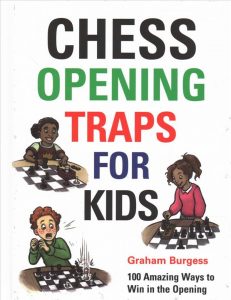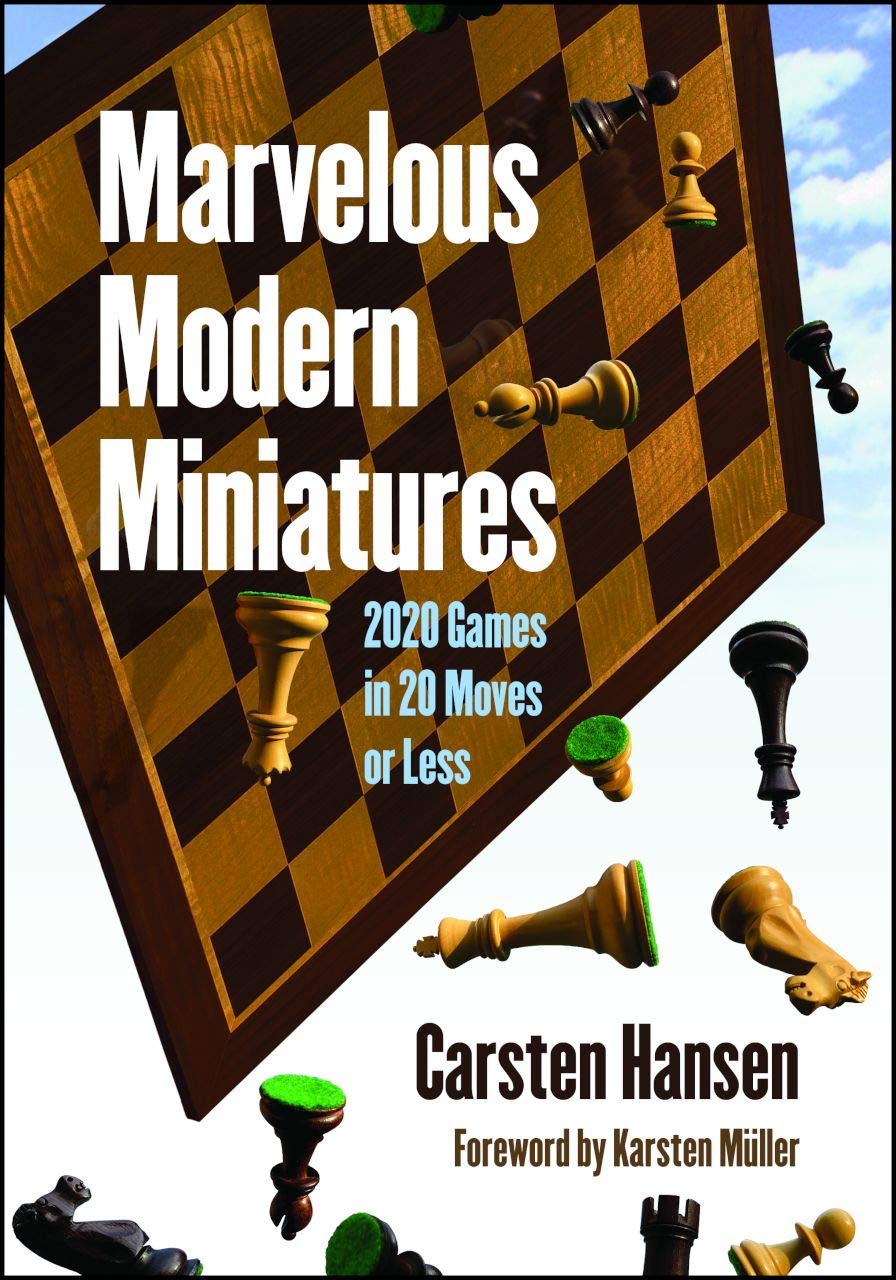
From the publisher:
“50% Tactics – 50% Opening Book – 100% Enjoyment! Enter the world of chess miniatures where games are decided in 20 moves or less! Marvelous Modern Miniatures features the largest collection of miniatures chess games played in the last half-century. Over 500 pages of cut and thrust! Although every player is rated at least 2100, the overwhelming majority are strong masters or grandmasters. You will follow them as they do battle with tactical fireworks raging around them. The surprising depth of the annotations (each one of the 2,020 games has meaningful comments) turns this book into a virtual course on tactics. Looking for traps and pitfalls in your favourite openings? You’ll probably find them here. Marvelous Modern Miniatures will improve your tactical skills and alertness and sharpen your opening play. As a bonus, the entire collection is immensely enjoyable!”
Cartsen Hansen is a Danish FIDE Master, FIDE Trainer and author of twenty-eight chess books on all phases of the game. He is a columnist for American Chess Magazine and Shakbladet.

This action packed book is an entertaining selection of opening/early middlegame disasters which includes some miniatures with world class players being crushed in twenty moves or less.
This book is naturally arranged by opening: on starting this book, I went straight to the section on my favourites. I offer four games from the fiery Dragon Variation.
The following game is a celebrated game which features a rare crushing loss for Dragon expert Jonathan Mestel against the late John Littlewood who was a fine feisty attacking player.
John Littlewood (2375) – Jonathan Mestel (2475)
British Championship Chester 1979
1.e4 c5 2.Nf3 d6 3.d4 Nf6 4.Nc3 cxd4 5.Nxd4 g6 6.f4 The Levenfish variation which is a decent alternative to the highly theoretical Yugoslav Attack. Bg7!? (Better is the standard 6…Nc6) 7.e5 Nh5 8.Bb5+ Bd7 9.e6!? (A dangerous line which must be handled carefully, but 9.Qe2 is better and leads to a white advantage) 9…fxe6 10.Nxe6 Bxc3+ 11.bxc3 Qc8 12.Bxd7+ Kxd7 13.Ng5 Qc4?! (13…Qxc3+ 14.Bd2 Qc4 15.Rb1 b6 16.Rb4 Qd5 17.Qg4+ Qf5 18.Qf3 Nc6 black is slightly better, for example 19.g4 Qc5 20.gxh5 Nxb4 21.Qb7+ Qc7 22.Qxc7+ Kxc7 23.Bxb4 gxh5) 14.Rb1 Kc7
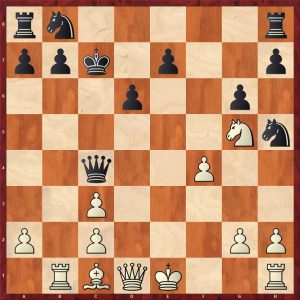
15.Rb4! Qxa2 The queen is very poorly placed here 16.Qe2 Nc6 17.Ne6+ 1-0 (Hopeless is 17…Kc8 18.Rxb7! Qa4 19.Rc7+ Kd8 20.0-0 Rc8 21.Rxc8+ Kxc8 22.f5 Nc6 23.Bg5 with a huge advantage)
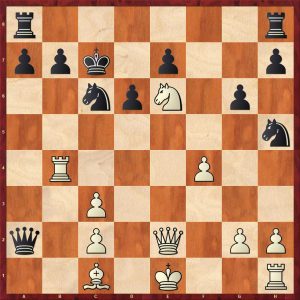
The second featured game in the Dragon variation features a well concealed mistake in the quiet g3 line, which the reviewer had not seen before despite having played the line with both colours.
Vladimir Georgiev (2564) – Evgeni Janev (2487)
Elgoibar 22.12.2001
1.Nf3 c5 2.e4 Nc6 3.d4 cxd4 4.Nxd4 g6 5.Nc3 Bg7 6.Nde2 Nf6 7.g3 0-0 8.Bg2 d6 9.0-0 a6 10.a4 Rb8 11.h3 b5 12.axb5 axb5 13.Be3 b4 14.Nd5 Nd7! 15.Nd4? A natural, but it is a well known mistake that is also seen in this setup with the colours reserved in the English Opening.
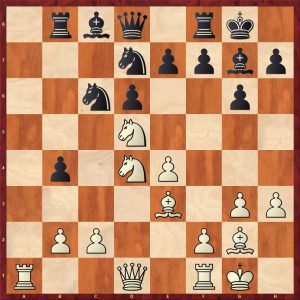
15…Bxd4! 16.Bxd4 e6 Winning a piece 17.Ne3 e5 18.Ba7 Rb7 Winning the bishop 0-1
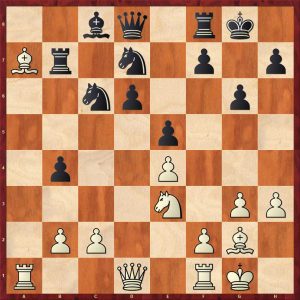
The next struggle features the Classical Variation of the Dragon. White essays the sharp Stockholm Attack which was venomous in its early days, but the theory was worked out many decades ago.
Perez,Robert M (2210) – Esserman,Marc (2453)
US Open Orlando 04.08.2011
1.e4 c5 2.Nc3 d6 3.f4 Nc6 4.Nf3 g6 5.d4 cxd4 6.Nxd4 Bg7 7.Be3 Nf6 8.Be2 0-0 9.Nb3 Be6 10.0-0 Rc8 11.g4 Na5 12.Nxa5 Qxa5 13.Bd4? [13.f5 Is better but black is at least equal after 13…Bc4]
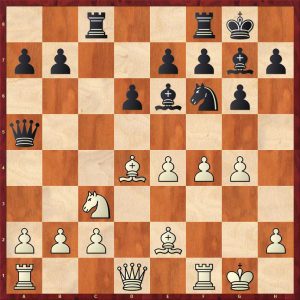
13…Bxg4! 14.Bxg4 Nxg4 15.Nd5 (15.Bxg7 Qh5! The main point: protecting the knight and threatening mate, before recapturing on g7) 15…Bxd4+ 16.Qxd4 e5 17.Qd1 Qc5+ 18.Kg2 Qxd5 0-1 (Black wins the queen back with Ne3+ followed by a crushing rook invasion on c2 a which gives an easily winning double rook ending.)
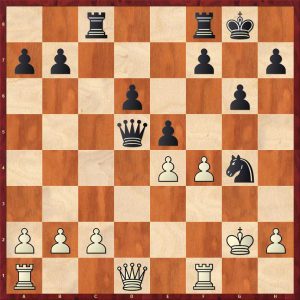
My last example Wyvern offering is from a main line in the highly theoretical Soltis Variation of the Yugoslav Attack.
Goran M Todorovic (2470) – Dejan Brankovic (2345)
Yugolavian Championship Kladovo 1996
1.e4 c5 2.Nf3 d6 3.d4 cxd4 4.Nxd4 Nf6 5.Nc3 g6 6.Be3 Bg7 7.f3 Nc6 8.Qd2 0-0 9.Bc4 Bd7 10.0-0-0 Rc8 11.Bb3 Ne5 12.h4 h5 13.Bg5 Rc5 14.Kb1 b5 15.g4 a5 16.gxh5 a4 17.h6 (17.Bxf6 is a critical alternative) 17…Bh8
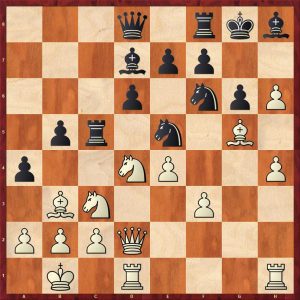
18.h7+ (18.Bd5 is really interesting.) Kxh7?? A bad blunder [18…Nxh7 leads to a complex struggle] 19.h5 Kg8 20.hxg6 1-0 (Black’s kingside is crumbling with no hope of support: catastrophe on the h-file follows imminently with the black king meeting a grisly execution.)
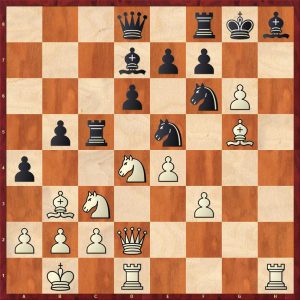
My next featured game is from an good old fashioned slugfest in the King’s Gambit, Double Muzio Variation and features the refutation to this Victorian romantic opening.
Stephen Brady (2320) – Mark Heidenfeld (2280)
Irish Championship Limerick, 1991
1.e4 e5 2.f4 exf4 3.Nf3 g5 4.Bc4 g4 5.0-0 gxf3 6.Qxf3 Qf6 7.e5 Qxe5 8.Bxf7+ Kxf7 9.d4 Qf5! (The bust, which leads to a large black advantage) 10.g4?? Much too weakening (10.Bxf4 Nf6 11.Nc3 Bg7 12.Rae1 d6 13.Qe2 Nc6 14.Be5 Qg4 15.Bxf6 Bxf6 16.Qxg4 Bxg4 17.Nd5 h5 18.Nxf6 Kg6 19.Nxg4 hxg4 20.Re4 Rhf8 with a winning endgame but black must still display some technique) 10…Qe6?! [10…Qg6! is even better] 11.d5? (Accelerating the loss, 11.Bxf4 is better still much better for black) 11…Bc5+ 12.Kg2 Qg6 13.Bxf4 Nf6 14.Be5
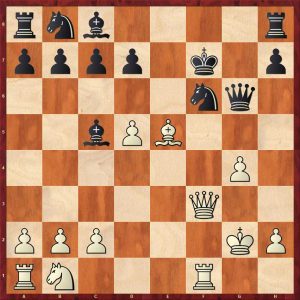
d6! The point of black’s play, the g4-pawn is targeted 15.Bxf6 Bxg4 16.Qf4 Bf3+! 0-1 (Forcing the exchange of queens, leaving black a clear piece to the good.)
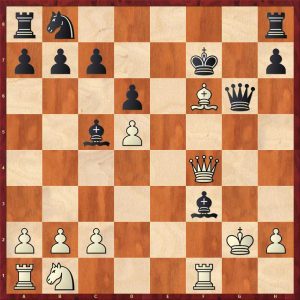
The next game features the dangerous Max Lange Attack in the Two Knight’s Variation for the Italian Game.
Kacper Piorun (2457) – Piotr Staniszewski (2383)
Polanica Zdroj Open 21.08.2009
1.e4 e5 2.Nf3 Nc6 3.Bc4 Bc5 4.0-0 Nf6 5.d4 exd4 6.e5 d5 7.exf6 dxc4 8.Re1+ Be6 9.Ng5 Qd5 10.Nc3 Qf5 11.g4 A sideline, 11.Nce4 is the main line: black is fine but must know a lot Qxf6?? A very common mistake (11…Qg6 is fine)
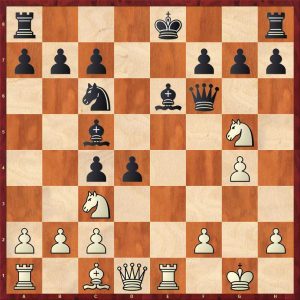
12.Nd5 Qd8 13.Rxe6+ fxe6 14.Nxe6 Qd7 15.Ndxc7+ Kf7 16.Ng5+ Kg6 [16…Kg8 is a slight improvement] 17.Qf3 Rad8 18.Nce6 (18.Qe4+ Kf6 19.Qf4+ Kg6 20.Nge6 also wins) 1-0
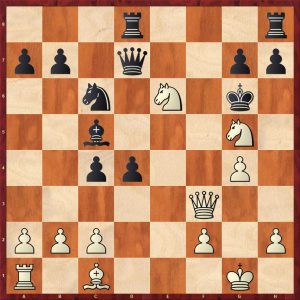
The next game shows a well known trap is the Scotch which two strong players were unaware of.
Delgado Ramirez (2620) – J. Gemy (2401)
Arica Open 2018 17.12.2018
1.e4 e5 2.Nf3 Nc6 3.Nc3 g6 4.d4 exd4 5.Nd5 Bg7 6.Bg5 Nge7?? [6…Nce7 is best] 7.Nxd4
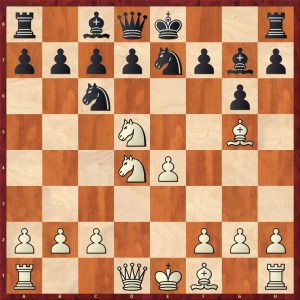
Bxd4? 8.Bxe7? [8.Qxd4! wins prettily 8…Nxd4 9.Nf6+ Kf8 10.Bh6#]
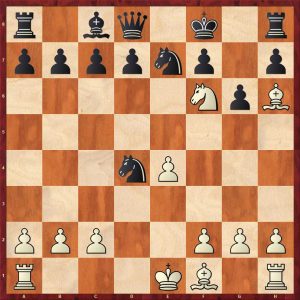
8…Nxe7 [8…Bxf2+ 9.Kxf2 Nxe7 10.Qd4 0-0 11.Nf6+ Kh8 12.Qc3 wins for white] 9.Qxd4 0-0 10.Nf6+ Kh8 11.0-0-0 [11.Qc3 is even stronger] 11…Nc6 12.Qc3 d6 13.Nd7+ Kg8 14.Nxf8 Qxf8 15.Bb5 Qh6+ 16.Kb1 Ne5 17.Qxc7 1-0
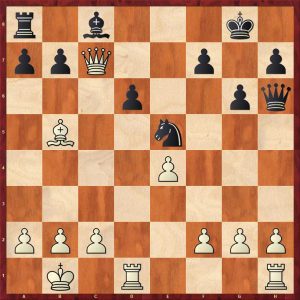
The following encounter features an ancient trap in the Steintz Variation of the Ruy Lopez, known since 1892. I have not seen this before!
Dusan Popovic (2363) – Tibor Jesenski (2361)
Senta Open 25.07.2002
1.e4 e5 2.Nf3 Nc6 3.Bb5 d6 4.d4 Bd7 5.Nc3 Nf6 6.0-0 Be7 7.Re1
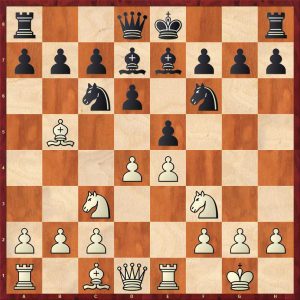
0-0? Falling into an ancient snare known since 1892. 8.Bxc6 Bxc6 9.dxe5 dxe5 10.Qxd8 Raxd8 11.Nxe5
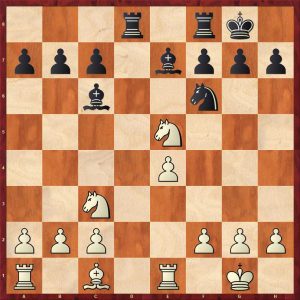
Bxe4? Black hopes that he can regain his pawn exploiting white’s weak bank rank 12.Nxe4 Nxe4 13.Nd3 f5 14.f3 Bc5+? 15.Nxc5 Nxc5 16.Bg5! The killer, this has happened many times
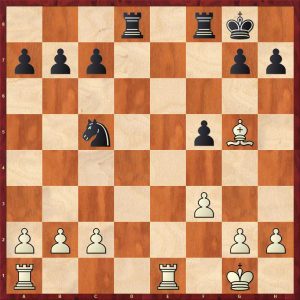
16…Rd7 [16…Rd5 17.c4 followed by Be7] 17.Be7 b6 18.Bxf8 Kxf8 19.Rad1 1-0
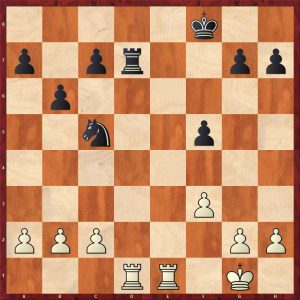
Here is a fine attacking game from the Queen’s Gambit Accepted which shows the dynamic potential in an isolated queen pawn (IQP) middlegame. Here the former world champion Anatoly Karpov is the victim, stuffed in 18 moves.
Ulf Andersson (2630) – Anatoly Karpov (2775)
Nykoping rapidplay Nykoping 1995
Notes by Baburin
1.Nf3 d5 2.d4 Nf6 3.c4 dxc4 4.e3 e6 5.Bxc4 c5 6.0-0 a6 7.Qe2 cxd4 8.exd4 Be7 9.Nc3 b5 10.Bb3 0-0 11.Bg5 Bb7 12.Rad1 Nc6 13.Rfe1 Nb4? This is quite a difficult line for Black anyway, but his last move is a serious mistake. (13…Na5?! 14.d5! Nxb3 15.dxe6 Qb6 16.axb3 fxe6 17.Nd4 Bd6 18.Qxe6+ Kh8 19.Nf3 Rad8 20.Bf4! Bxf3 21.Rxd6 Rxd6 22.Qxd6 Qxd6 23.Bxd6 Re8 24.Rxe8+ Nxe8 25.Be5+- Boleslavsky-Kotov, Zurich, 1953.;
13…Nd5 14.Nxd5 Bxg5 15.Nb6!? Bronstein. 15…Qxb6 16.Nxg5)
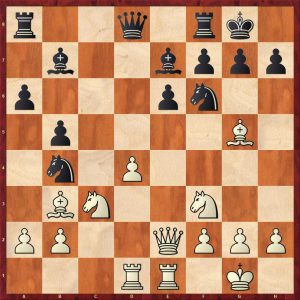
14.d5! This thematic break works really well for White, due to his superior development, in fact this move was analysed long ago by Russian master V. Rauzer! 14…Nfxd5 15.Nxd5 Bxg5 16.Nxb4 Qe7 17.Nd5 Bxd5 18.Bxd5 1-0
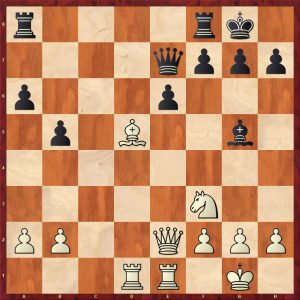
The reviewer’s last offering shows an instructive loss by another former World Champion is just six moves. He followed a previous game Miles-Christansen where both players missed white’s sixth move winning a piece!
Alonso Zapata (2480) – Vishy Anand (2555)
Biel 1988
1.e4 e5 2.Nf3 Nf6 3.Nxe5 d6 4.Nf3 Nxe4 5.Nc3 Bf5?? This had been played by Christiansen against Miles who played 6.Nxe4? [5…Nxc3 is the main line] 6.Qe2 winning a piece 1-0 (6…Qe7 is met by 7. Nd5 whereas 6…d5 is met by 7.d3
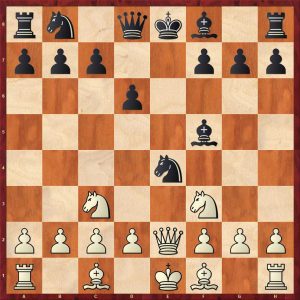
In summary, this is a good read which revealed traps that the reviewer had not seen before. It just shows that even titled players can fall into lost positions very quickly.
I have one small criticism: the reviewer quickly spotted a couple of typos in the book but this does not detract from a didactic book. Look up your favourite openings and you may be surprised!
FM Richard Webb, Chineham, Hampshire, 31st May 2021

Book Details :
- Softcover : 424 pages
- Publisher: Russell Enterprises (1 Dec. 2020)
- Language: English
- ISBN-10: 1949859223
- ISBN-13: 978-1949859225
- Product Dimensions: 17.78 x 3.18 x 25.4 cm
Official web site of Russell Enterprises


